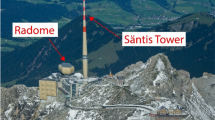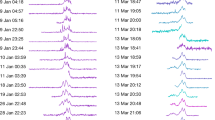Abstract
A long-lived (>32 min) persistent meteor train has been observed with a low light television camera which was sensitive only to radiation between wavelengths of 700 and 900 nm. The peak emission from the train was about 2 × 1017 photons s−1 m−1 and the meteor which produced the train had a magnitude corrected to the zenith of about −6. It is suggested here that this IR emission arises from the excitation of the atmospheric band of molecular oxygen (b1Σg→X3Σg) by the sodium catalytic process, a process which Baggaley1–3 has previously proposed to be responsible for the visible radiation from persistent meteor trains.
This is a preview of subscription content, access via your institution
Access options
Subscribe to this journal
Receive 51 print issues and online access
$199.00 per year
only $3.90 per issue
Buy this article
- Purchase on Springer Link
- Instant access to full article PDF
Prices may be subject to local taxes which are calculated during checkout
Similar content being viewed by others
References
Baggaley, W. J. Bull. astr. Insts Csl. 27, 244–246 (1976).
Baggaley, W. J. Nature 257, 567–568 (1975).
Baggaley, W. J. The Observatory 98, 8–11 (1978).
Lovell, A. C. B. Meteor Astronomy, 131 (Oxford University Press, 1954).
Colin, L. & Myers, M. A. Computed Times of Sunrise and Sunset in the Ionosphere (NASA TM X-1233, 1966).
Chapman, S. in The Aurora and Airglow (eds Armstrong, E. B. & Dalgarno, A.) 204–205 (Pergamon, Oxford, 1955).
Chapman, S. J. geophys. Res. 64, 2064–2065 (1959).
Kolb, C. E. & Elgin, J. B. Nature 263, 488–490 (1976).
Zipf, E. C. Can. J. Chem. 47, 1863–1870 (1969).
Baggaley, W. J. Bull. astr. Insts Csl. 28, 356–359 (1977).
Author information
Authors and Affiliations
Rights and permissions
About this article
Cite this article
Hapgood, M. IR observation of a persistent meteor train. Nature 286, 582–583 (1980). https://doi.org/10.1038/286582a0
Received:
Accepted:
Issue Date:
DOI: https://doi.org/10.1038/286582a0
This article is cited by
-
VIDEO AND PHOTOGRAPHIC SPECTROSCOPY OF 1998 AND 2001 LEONID PERSISTENT TRAINS FROM 300 TO 930 nm
Earth, Moon, and Planets (2004)
Comments
By submitting a comment you agree to abide by our Terms and Community Guidelines. If you find something abusive or that does not comply with our terms or guidelines please flag it as inappropriate.



